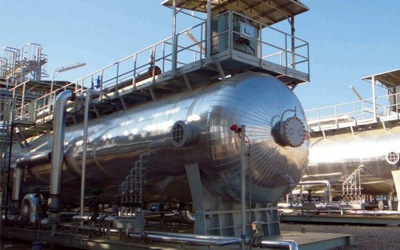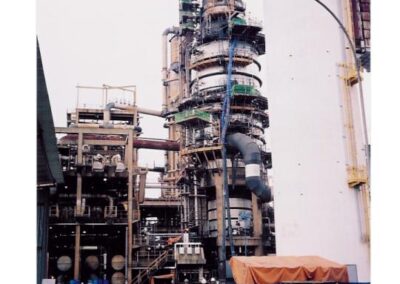Part 6
Part 6, focusing on removing heavy organic deposits from the crude unit, in the series on how the chemical industry is solving challenges in the industrial sector. In today’s age, refineries are using a growing percentage of low API gravity crude oil stocks. This crude slate means that the crude oil contains higher molecular weight compounds such as waxes and asphaltenes.
Many refineries are integrated to process the larger amounts of heavy compounds through Coker Plants, Asphalt Units, and other such processing equipment. Through this process, removing heavy organic deposits from the crude unit becomes critical.
As these heavier crudes are run through the distillation and purification processes, inevitably heavy compounds settle in and foul equipment. And removing heavy organic deposits from the crude unit becomes a priority. This fouling process starts as “sludge” build-up in crude storage tanks. Depending on the number of years between tank cleaning activities, it is not uncommon to have several feet of deposited heavy crude sludge; literally up to 100,000 barrels, and more, of debris. The fouling with heavy deposits continues in the desalter drums, heat exchangers, the furnace and the atmospheric and vacuum towers.
In crude oil tank storage, the debris is a mixture of wax, asphaltenes, brine water, production sand, and tank rust scale. These dark oil tanks are often large with diameters of up to 300 feet of more. The challenge of removing built-up crude oil sludge debris is—at best—a daunting and very expensive exercise. Many man-hours, lots of equipment, the use of large amounts of a hydrocarbon-based cutter oil, exposure to personnel injury, many months of vessel outage time, large volumes of expensive waste disposal and hundreds of thousands of dollars in cost. One 260’ diameter crude oil vessel that I am personally familiar with took over 9 months to complete, cost the refiner over $1.6 MM in labour costs and much more in waste disposal fees.
What is the process for removing heavy organic deposits from the crude unit tank?
The common practice is to de-inventory as much pumpable oil liquids as is possible and then a process of trying to get the immovable materials out of the vessel. Many methods have been attempted, including robots, tank-mounted nozzles and eventually cutting a big hole in the side of the tank and sending men inside to physically “suck” the debris out with a super-sucker vacuum truck. This process has become known in the industry as the “muck and suck” method. The robots and nozzle systems all have some design to spray hot cutter oil onto the sludge. The hope here is to dilute the sludge with enough cutter oil to thin out the viscosity and allow the sludge to become movable through vacuuming.
Nozzle systems that are either mounted inside the tank and or are manway mounted are designed to pump the liquid inside the tank around and trying to suspend the heavy particulates in the crude oil thereby minimizing the heavy fall-out and accumulation that will occur. These systems require externally operated pumps and a regular mixing schedule to have some positive effect.
With the manual labor “muck and suck” processes, the tank debris is typically run through a centrifuge to minimize the waste volumes. Even with this, the removed organic debris is costly to dispose of as a hazardous waste. The waste disposal cost alone can be more than a $1.0 MM.
The cleaning process may involve a degreasing step following the bulk sludge removal. This is typically done with water-based cleaners. Depending on the vessel contents, the tank must also be “degassed”. This is to say having all of the light hydrocarbon vapor, possible hydrogen sulfide content and any other potentially hazardous vapor eliminated before vessel manned entry can be done.
With these processes, the potential for an environmental mess and an expensive clean-up also exists. Putting people inside a confined space wearing moon suit safety gear increases personnel risk. Imagine the problem of doing this work in the warmer summer months where the temperatures inside the tank can easily exceed 38°C (100°F). A possible safety issue from heat exhaustion on top of everything else.
What does a refiner do when they need to remove heavy organic deposits?
They must clean these tanks on a schedule of every 10 years to perform an API 653 inspection for integrity. While this work is always a challenge and is always going to be expensive, can the refiner mitigate his risks? Can the refiner control his cost for doing the work and maybe even get a net back in financial performance? Luckily, the industry is developing better, safer, quicker, less expensive methods for doing tank cleaning. So, the answers to all of the above questions is a strong YES.
Innovative companies are developing very effective chemical processes for liquefying organic solids eliminating a large percentage of the waste volumes and therefore greatly reducing waste disposal costs. So what happens to the fluidized organic solids? Well, they are almost 100% recovered for re-introduction into the refining process and/or sold directly as a merchantable product – right out of the tank. Money saved and money earned at the same time.
These chemical processes are conducted from the exterior of the tank with minimal personnel. Now, don’t be mistaken here. The contractor must know what they’re doing and have the proper equipment to achieve the required mechanical conditions for removing heavy organic deposits from the crude unit. Moreover, the contractor cannot just add Magic Dust 123 or Snake Oil 345 claiming that this stuff works and be successful. The contractor must have a historically proven chemical product used in exactly this type of project. The chemical products must be safe and, as importantly, have been evaluated so the chemical has no harmful impact in the refining processes. No emulsion formation, no corrosivity issues, no catalyst poisons. Every refiner knows the importance of these matters.
While these products are few, they do exist. They will work as advertised and make you money. Imagine that after all the costs of the job (labor, equipment, chemicals, cutter stock, waste disposal and supplies) have been accounted for that you could see a positive cash back to your bottom line. Yes, better, safer, quicker and less expensive. This is available now and not a tank dream.



